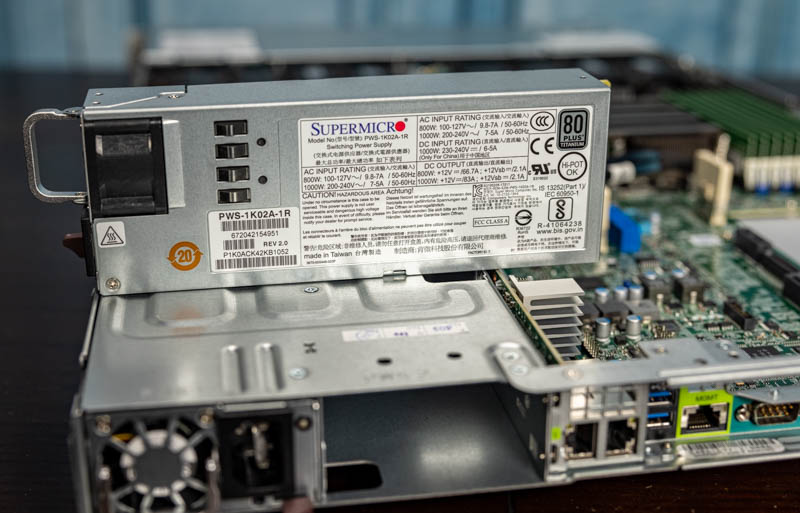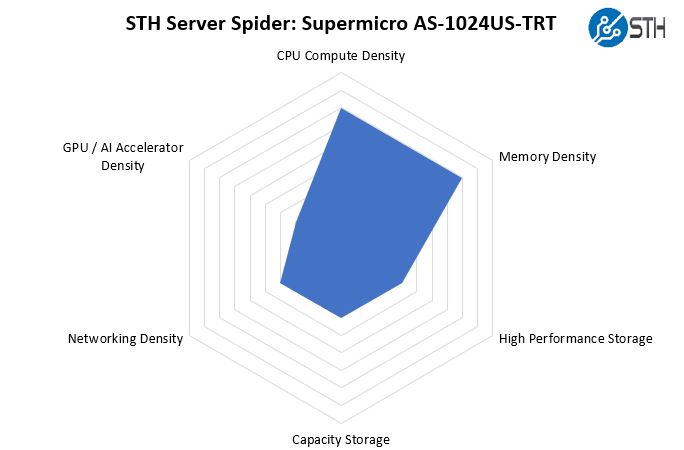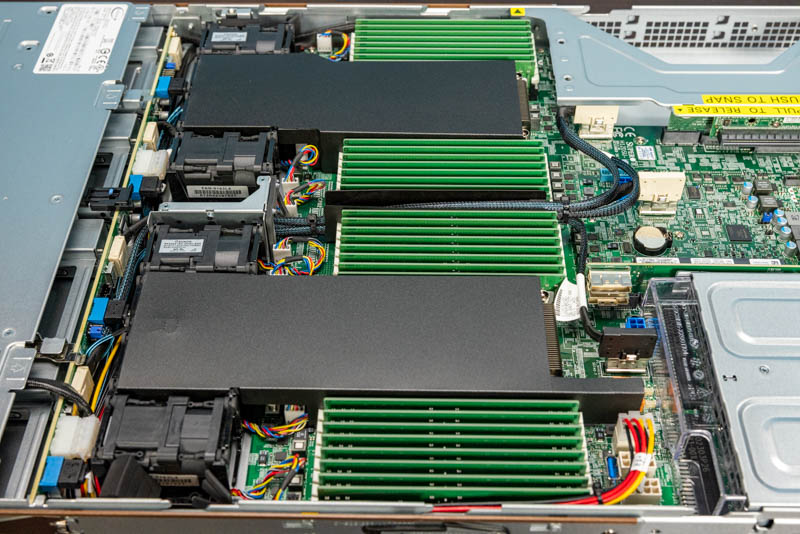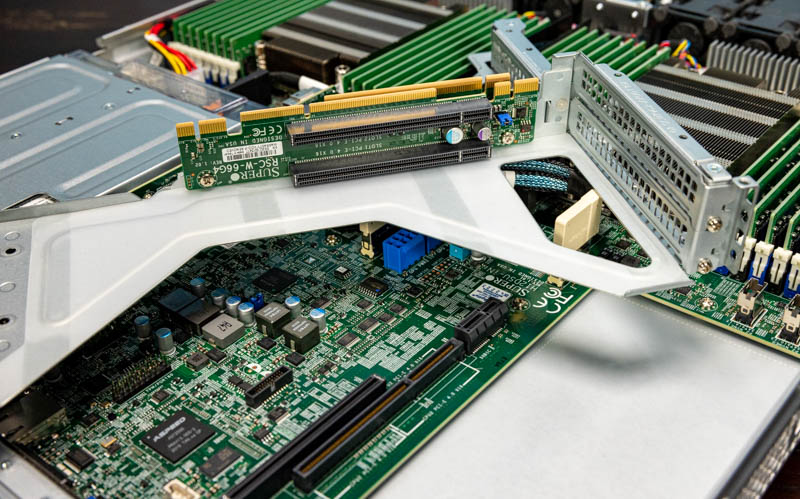Power Consumption
Since we had a relatively full configuration, we wanted to see if the 1kW 80Plus Titanium PSUs were sufficient.

- Idle: 0.17kW
- 60% Load (non-AVX): 0.68kW
- 100% Load: 0.74kW
- AVX-512 GROMACS Load: 0.78kW
We tested these in our data center with 70% RH on 208V power. One time we noticed is that the power supplies only put out 800W at 110/120V. As such, one may want to configure a system with different power supplies if using a lower-voltage rack.
STH Server Spider
In the second half of 2018, we introduced the STH Server Spider as a quick reference to where a server system’s aptitude lies. Our goal is to start giving a quick visual depiction of the types of parameters that a server is targeted at.

Here we have a fairly standard type of STH Server Spider for a system in this class, perhaps with the exception of the storage. That is due to the fact that we have 3.5″ bays in this system while we do not in many of the 2.5″/ SSD-only configurations we test. Still, the goal of this server is to be a well-rounded 1U server which is a role it fits well.
Final Words
Hopefully, in this review, you got a sense of the what, why, and how this server was constructed. As part of Supermicro’s portfolio, the AS-1024US-TRT is a specific configuration within the context of a broader 1U AMD EPYC portfolio, which is part of the broader Ultra-style EPYC portfolio, that is within the broader AMD portfolio, and the broadest Supermicro portfolio. That is a lot of layers. At the same time, the influences on this server are not just what is in the machine itself, but it is also the context around how it is released. That explains why and how the server is being designed for specific customer segments and needs.

Overall, this system performed well. With dual AMD EPYC 7003 “Milan” processors a lot of expandability, this system is designed to consolidate two older generation Intel Xeon or even AMD EPYC 7001 series servers into a single 1U platform. The impact of 2:1 consolidation is enormous in this segment.

If you are looking for a dual AMD EPYC 7003 series “Milan” server that has a lot of expandability and pronounced design objectives, then this server from Supermicro is an excellent option.




I wish STH could review every server. We use 2U servers but I learned so much here and now I know why it’s applicable to the 2U ultras and Intel servers.
Hi Patrick, does AMD have a QuickAssist counterpart in any of their SKUs? Is Intel still iterating it with Ice Lake Xeon?
I’m fascinated by these SATA DOMs. I only ever see them mentioned by you here on STH, but every time I look for them the offerings are so sparse that I wonder what’s going on. Since I never see them or hear about them, and Newegg offers only a single-digit number of products (with no recognition of SATA DOM in their search filters), I’m confused about their status. Are they going away? Why doesn’t anyone make them? All I see are Supermicro branded SATA DOMs, where a 32 GB costs $70 and a 64 GB costs $100. Their prices are strange in being so much higher per GB than I’m used to seeing for SSDs, especially for SATA.
@Jon Duarte I feel like the SATA DOM form factor has been superseded by the M.2 form factor. M.2 is much more widely supported, gives you a much wider variety of drive options, is the same low power if you use SATA (or is faster if you use PCIe), and it doesn’t take up much more space on the motherboard.
On another note, can someone explain to me why modern servers have the PCIe cable headers near the rear of the motherboard then run a long cable to the front drive bays instead of just having the header on the front edge of the motherboard and using short cables to reach the front drive bays? When I look at modern servers I see a mess of long PCIe cables stretching across the entire case and wonder why the designers didn’t try avoid that with a better motherboard layout.
Chris S: It’s easier to get good signal integrity through a cable than through PCB traces, which is more important with PCIe 4, so if you need a cable might as well connect it as close to the socket as possible. Also, lanes are easier to route to their side of the socket, so sometimes connecting the “wrong” lanes might mean having to add more layers to route across the socket.
@Joe Duarte the problem with the SATA DOMs is that they’re expensive, slow because they’re DRAM-less, and made by a single vendor for a single vendor.
Usually if you want to go the embedded storage route you can order a SM machine with a M2 riser card and 2x drives.
I personally just waste 2x 2.5” slots on boot drives because all the other options require downtime to swap.
@Patrick
Same here on the 2×2.5″ bays. Tried out the Dell BOSS cards a few years ago and downtime servicing is a non-starter for boot drives.
I should maybe add that Windows server and (enterprise) desktop can be set to verify any executable on load against checksums, which finds a use for full size SD cards for my shop (and greatly restricts choice of laptops). the caveat with this is that the write protection of a SD card slot depends on the driver and defaults to physical access equals game over. So we put our checksums on a Sony optical WORM cartridge accessible exclusively over a manually locked down vLAN.
(probably more admins should get familiar with the object level security of NT that lets you implement absolutely granular permissions such as a particular dll may only talk to services and services to endpoints inside defined group policies.the reason why few go so far is highly probably the extreme overhead involved with making any changes to such a system, but this seems like just the right amount of paranoia to me)